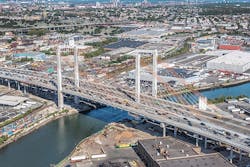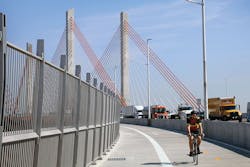NO. 1 BRIDGE: Kosciuszko Bridge—Phase 2
As New York City’s first major bridge crossing since 1964, the new Kosciuszko Bridge was completed four years ahead of schedule and on budget.
With completion of the first span in 2017, the new bridge replaces a 1.1-mile segment of the Brooklyn-Queens Expressway (BQE) with two innovative parallel structures each with a single-tower cable-stayed main span over Newtown Creek. The signature bridges provide a gateway between Brooklyn and Queens, redefining the New York City skyline. The original 1939 bridge was structurally deficient, resulting in a functionally obsolete bottleneck on one of New York City’s few north-south interstates. Maintenance had become costly and more frequent, so it was determined the bridge should be replaced to ensure the safety of its 180,000 daily motorists.
“The entire team is so proud to have worked on the new Kosciuszko Bridge, alleviating one of the worst traffic bottlenecks in New York City, while adding a signature structure to the city skyline,” Carol Wynperle, P.E., WSP USA project manager, told Roads & Bridges. “The new bridge not only benefits vehicular travel but also provides a new bikeway-walkway, providing a connection between communities that didn’t exist before, as well as new parks and open spaces in both neighborhoods.”
In 2009, an alternatives analysis was initiated by WSP, which considered numerous structure types for the main span. Two parallel structures each with a single tower cable-stayed main span were selected.
Due to funding constraints, the project was broken into two phases—Phase 1 included the construction of the new eastbound (Queens-bound) span and Phase 2 constructed the new westbound (Brooklyn-bound) span. Phase 2 was progressed as a traditional design-bid-build best value contract. WSP provided the final design of the Phase 2 structure while Phase 1 was under construction and completed final detailed plans six months ahead of schedule. This allowed a seamless transition between the Phase 1 and Phase 2 construction contracts.
Single-tower cable-stayed structures are rare, and this bridge was made even more exceptional by the unique, unbalanced span arrangement that accommodates environmental and local roadway constraints below. The Phase 2 cable-stayed structure has a front span of 609 ft and the back span is 343 ft. The single tower support is located on the Queens side of Newtown Creek and extends to a height of 287 ft. This is just below the maximum height permitted, due to its proximity to the LaGuardia Airport approach pattern.
A concrete and steel counterweight was designed and constructed at the end of the back span to balance the large weight differential due to the differing lengths. On a cable-stayed structure, high wind or rain events can result in high amplitude vibrations of the cables. Internal hydraulic dampers were installed at each cable to absorb this energy and dampen the vibration effects, which minimizes the motion of the cable, reduces fatigue effects, and ensures the stability of the structure.
The precast concrete deck is supported by steel floor beams and edge girders. The 56 stay cables, placed at various angles to connect the edge girder to the two vertical legs of the pylon, comprise nearly 1 million linear ft of steel strands. To help reduce future maintenance requirements and provide a 100-year service life, the structural steel was metalized. In addition, a 1-in.-thick polyester polymer concrete overlay was applied over the precast deck panels to protect against chloride infiltration and premature deck deterioration. Stainless steel rebar in the deck and concrete cap beams under expansion joints helps protect against future concrete spalling and cracking.
The roadway incline was lowered 35 ft, helping trucks and larger vehicles maintain consistent speeds as they cross the bridge. The new wider structures provide three additional traffic lanes to accommodate traffic volume and provide wider shoulders and improved merge and weave distances, promoting safer conditions for drivers.
A 20-ft shared-use pathway was added. The main span has a state-of-the-art aesthetic lighting system. The system includes multi-colored LED lights that illuminate the cables and tower, and can be programmed for dynamic light shows.
The retaining walls along the lower portions of the approaches in both Brooklyn and Queens utilize prefabricated T-walls with custom form liners to enhance the overall aesthetics from the local street network and open spaces below the bridge.
The team delivered a signature bridge that redefines the Manhattan skyline, with the first cable-stayed structure in New York City. The graceful design provides motorists and pedestrians a clear, unobstructed view as they cross the boroughs. Built to last the next 100 years, the sustainable design minimizes maintenance costs.



